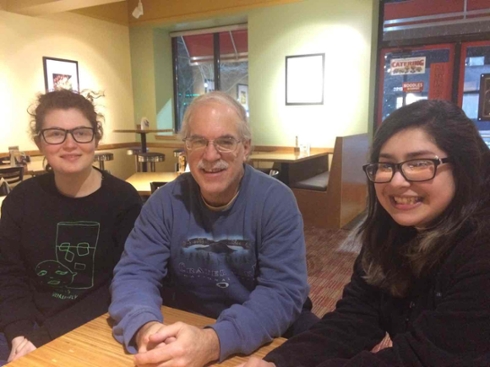Tags
"astronomy"
Astronomy at the University of Michigan: Lizzy Arellano, Winter Shadow 2016

Going to dinner
The winter shadow that I had the pleasure of going to was far more fulfilling than I ever thought it could be. My hosts were very kind. Their homes were beautiful and their hospitality was very much appreciated. Ann Arbor, Michigan, was one of the most beautiful and easy to get around towns that I’ve ever visited. Mario Mateo’s house was about 2 miles from the University of Michigan, where Sarah and I worked most of the time. We found ourselves really looking forward to the walks every day. Not only was it really nice to pass through the urban and suburban areas of Ann Arbor, but it also gave us an opportunity to explore the downtown more. The food was delicious, the sights were see-worthy, and the snow was puffy. I feel so grateful to have received this externship because I will have otherwise never been able to visit Michigan.
As for the actual project, it was a great experience overall. Not only did I learn a lot of Python, a coding language, but also, I gained experience as an intern. I learned about the actual process of working with a data set and getting real results from my work that could actually contribute to scientific process. Because we were using data from the Magellan Clay Telescope in Chile, where each fiber attached to a plate referred to a specific star in the star cluster, Omega Centauri, we were working off Mateo’s idea of a new way of star cluster analysis. We had to be very careful with our calculations, checking and rechecking for the expected results. We had to generalize our coding, so that when new data comes in, it could be analyzed using the same programs and so that people all over the world would have the opportunity to do the same type of analysis. At the end of our externship, our work rewarded us with a complete spectrum of the stars we analyzed, which allowed Mateo to analyze the spectral lines for different elements contained in the stars.
Astronomy at the University of Michigan: Sarah Racz, Winter Shadow 2016

The first thing I did when I found out I was accepted for the Winter Shadow program in Astronomy at the University of Michigan Ann Arbor was look into getting a parka. I was excited to visit Ann Arbor for the first time, and really hoping for some snow.
I stayed in Ann Arbor for a week, and left with unending love for what has become my favorite diner of all time.
I worked with a Mario Mateo, who is an astronomer at the University of Michigan. The project I worked on sought to measure the dependence of the magnitudes of RR Lyrae stars upon metal abundance. RR Lyrae stars are variable stars, known for having short periods. All the stars we observed were from the globular cluster Omega Centauri, which is a cluster known for having a range in the metallicities of its stars. All the data was from a telescope in La Serena, Chile that Mario had built. During the week I wrote several scripts in Python to read from huge files of data and run data analysis.
ASTRON Institute: Irene Globus-Harris, Winter Fellowship for International Travel

Westerbork
Irene Globus-Harris, sophomore physics major and recipient of the Winter Fellowship for International Travel, reflects on her time in Dwingeloo, the Netherlands, at ASTRON, the Netherlands Institute for Radio Astronomy.
++++++++++++++
The Dutch national color is orange. Bright orange, the type that hurts your eyes after staring at it too long. As I flew in at the break of dawn, the entire sky—awash in an intense, orange sunrise—seemed to reflect that fact. I spent the first few days visiting my host family and friends in North Holland, then headed to Dwingeloo to begin my work at ASTRON. Dwingeloo is small—more of a village than a town, and is adjacent to one of the Netherlands’ largest national parks, the Dwingelderveld. ASTRON itself sits within that national park which made the bike ride in exceptionally beautiful.
